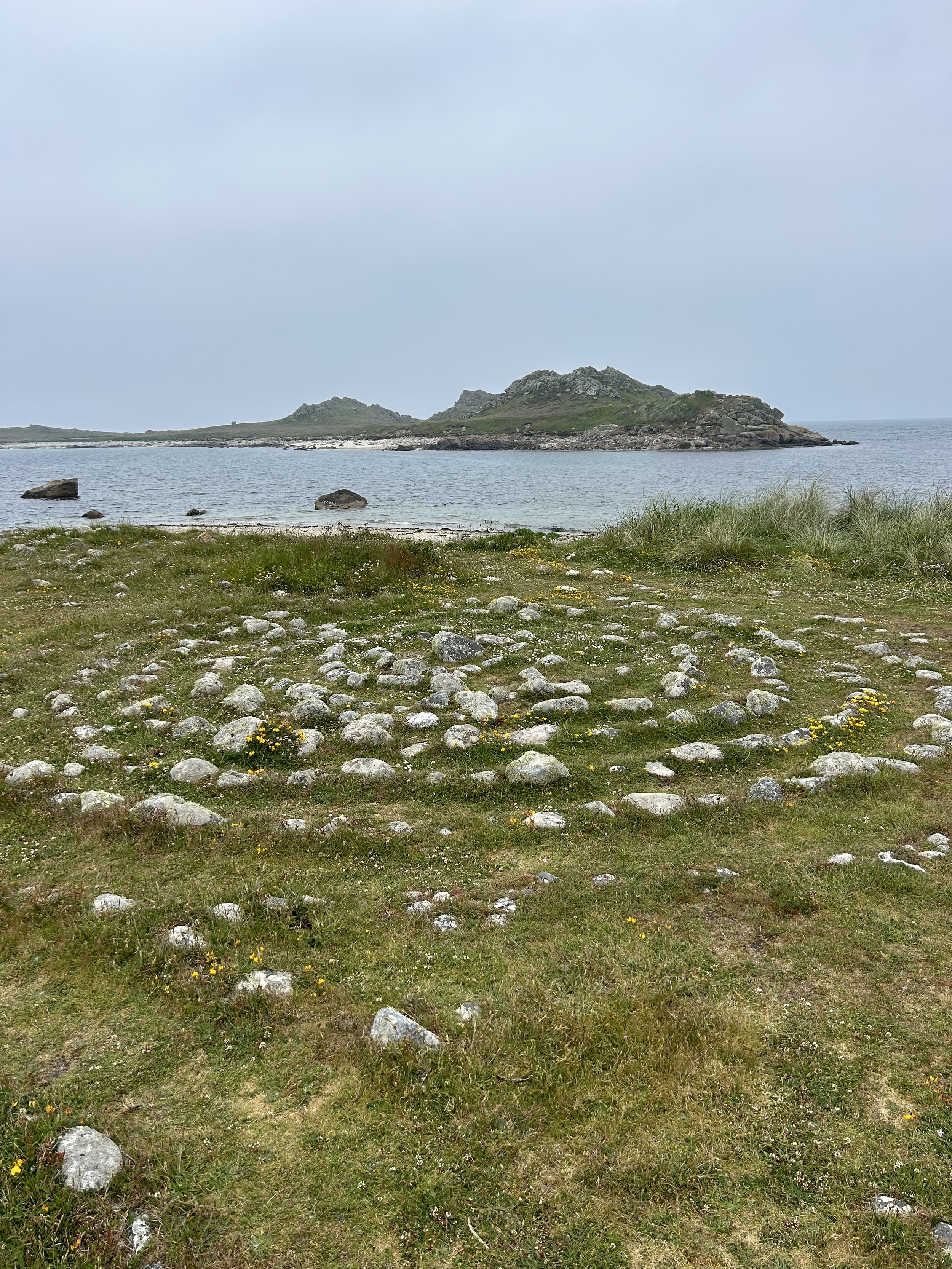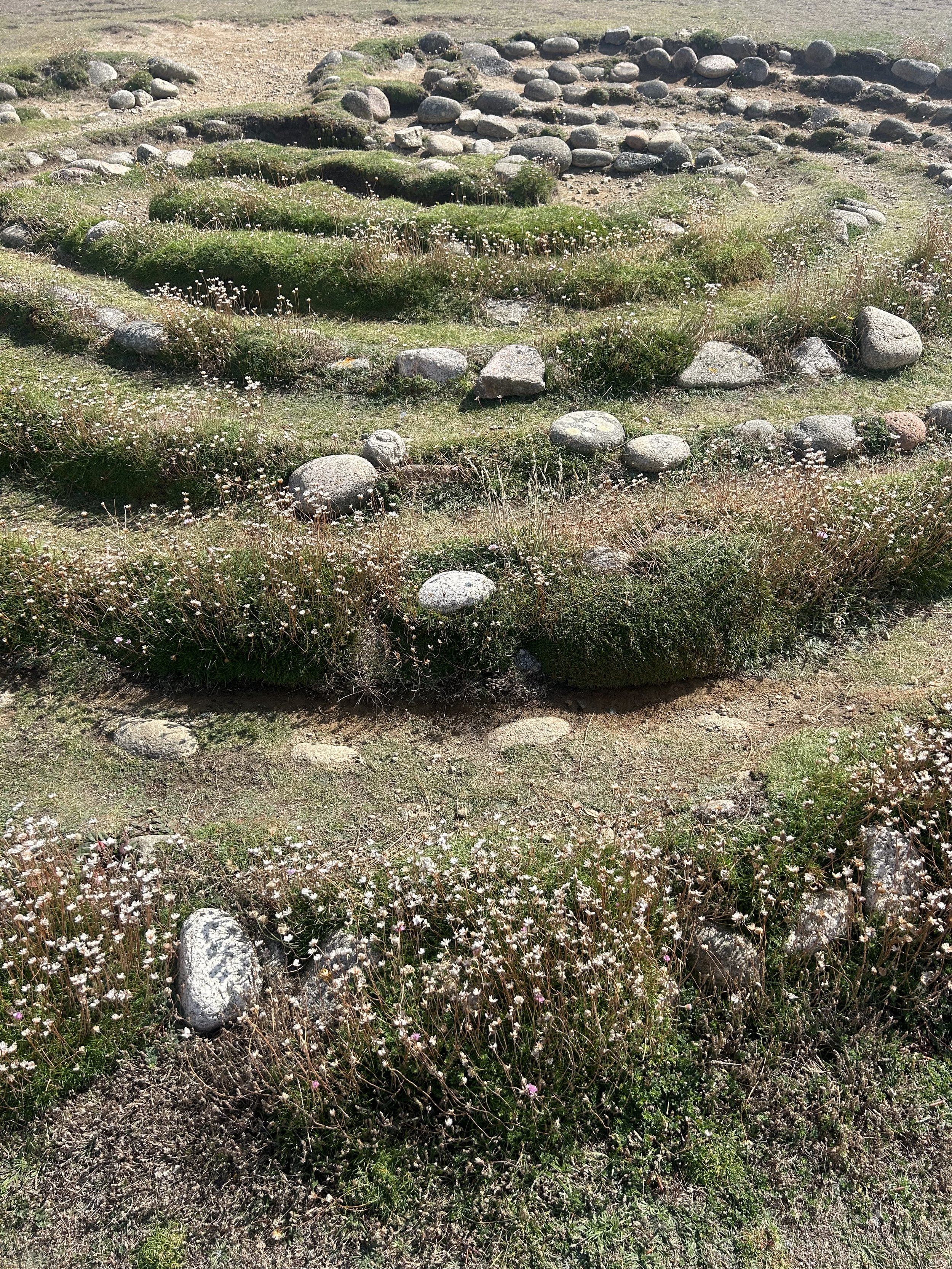
Vanishing Labyrinths of the Isles of Scilly
A public art project celebrating the history, culture, and folklore surrounding the phenomenon of pebble mazes on the Isles of Scilly
Vanishing Labyrinths of the Isles of Scilly
A public art project celebrating the history, culture, and folklore surrounding the phenomenon of pebble mazes on the Isles of Scilly
Filming of St Martin’s White Island Bar Mazes by James Faulconbridge
About the Project
The Isles of Scilly - a small archipelago twenty-eight miles from the south west tip of Cornwall - have an iconic and enigmatic labyrinth heritage unique to the British Isles. These spiralling configurations of sea-worn pebbles placed on turf bloom across the islands’ coasts like toadstools - fairy rings of unknown origin. The first and oldest of these labyrinths (coiling single paths, known locally as mazes) is Troy Town Maze on St Agnes, the smallest and most remote of Scilly’ inhabited islands. This maze is at least 300 years old - but possibly far older - as it shares many similarities with labyrinths from the Viking period. Though there are several like it on small islands in Scandinavia, it is the only one of its kind in the UK. Troy Town Maze was the inspiration for several other labyrinths that have appeared around the islands over the decades. Like the original, all of these are of uncertain date, but unlike the original, these later mazes are archaeologically unacknowledged. Instead they are cared for, walked and modified by generations of islanders and visitors to Scilly.
Labyrinths are ancient symbols of pilgrimage, folklore and sea-faring superstition - sparking curiosity and imagination. So perhaps it is only fitting that a folk-culture of labyrinth building emerged on the islands, which are so rich in natural beauty and cultural heritage. However, very little is known about Scilly’s labyrinths. Their important story is largely untold, and most people - visitors and islanders alike - are unaware of their significance. Because of this, they are vulnerable. Many have already vanished from the coastpaths - their stones rolled aside in high winds, overgrown by vegetation, or covered by shifting sands - and now they survive only in memory. This community art project aims to lift up the importance of Scilly’s labyrinths. Firstly, and more generally, by hosting a range of labyrinth-inspired cultural content to the islands; and secondly, more specifically, with the restoration of Giant’s Castle maze.
Folk Heritage Restoration: Giant’s Castle Maze
Giant’s Castle Maze, photo by Teän Roberts, 2019
Diagram of Giant’s Castle Maze by Jeff Saward, 1990
Giant’s Castle Maze is a labyrinth of obscure origin and unknown date. First accounts of these stone-and-turf coils encircling a central quartz crystal on the St Mary’s coast path emerge around 1950. Not quite natural, not wholly human, it is an esoteric piece of folk-history that has been transformed and distorted over time: shaped by wind and coastal spray, the slow growth of heather, and generations of island feet. In recent years its twisting paths have meandered too far, drifting so deeply into mazey confusion – teetering on the edge of the known – that their pattern is in danger of being entirely lost. Our project will begin by seeking as much information as possible about this mysterious site - by researching in museum archives, speaking to local residents and visitors to the islands, and seeking out photographs and drawings from heritage professionals. We will partner with: Scilly’s premier archaeologist; experienced ecologists and wildlife conservationists; a digital surveyor and technologist; and expert dowsers, to survey this unique site - considering artistic, archaeological, ecological and mythological perspectives on the maze. All this information will inform a community-led restoration of this site, in the hope of preserving it for years to come.
Gian’t Castle Maze, St Mary’s, Isles of Scilly
Photogrammetry scan of Giant’s Castle Maze, 2024
“The Giant’s Castle stone maze always seemed to be a somewhat overlooked little example that gets far less attention than the more famous St Agnes and St Martins mazes… It is the nature of those stone mazes that they will morph a bit over the years, and that’s part of their history. ”
The History of Scilly’s Vanishing Labyrinths…
Sites of weather-magic, fairy lore, pilgrimage and folk art – stories associated with the labyrinths are also vulnerable to erosion, slipping out of memory and needing our care. Alongside the Giant’s Castle restoration, our project will illuminate the uniqueness and importance of these strange island symbols by encouraging engagement with their histories, purpose and meanings.
Scilly has four main surviving labyrinth sites…
…and several that have already been lost
Garrison, St Mary’s
West Porth, Samson
Chapel Down, St Martin’s
White Island Bar, St Martin’s
Popplestones, Bryher
Children’s Voices…
Our research started by asking some of the younger members of the island community what the labyrinths mean to them…
Follow more of our research into Scilly’s labyrinth heritage on our Blog Page, where we will be posting regular updates.















